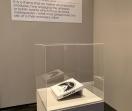Curated by Acoris Andipa, Stefano Antonelli and Gianluca Marziani,
“If you want to say something and have people listen, then you have to wear a mask. If you want to be honest then you have to live a lie.” – Banksy
Few have ever seen him, fewer know his face, and no photos showing him are circulating, yet Banksy conquers the world through his work of unprecedented ethical, evocative and thematic power to become the ‘people’s hero’. Banksy's images are simple but not elementary; with messages that examine the themes of capitalism, war, social control, and freedom in the broadest sense, and within the paradoxes of our time.
The exhibition will explore the mindset of the artist known as Banksy and the thinking behind this quote that allows him to say and do things that many of us wished we could say and do ourselves. By examining over 100 original works, installations, objects and prints the exhibition examines the concept of the mask, both for the artist to protect his identity and the mask that we all present to the outside world.
Born in Bristol around 1974, generically classified as Street Artist, Banksy is an exemplary case of popularity for a living artist that the art world has not seen since the days of Andy Warhol.
Unlike most of the worldwide exhibitions of Banksy artworks this is curated by an academic team for the purposes of a scientific review. Exploring how Banksy represents the evolution of Pop Art whilst jolting his audience into thinking of social and politic conflictions is to play a major role in this museum show.
The exhibition is curated by two of the curators from the first major exhibition of Banksy artworks, presented at the Rome Foundation’s museum in 2016, Mr Acoris Andipa and Mr Stefano Antonelli, joined now by the curator Mr Gianluca Marziani. Organised by the cultural association, MetaMorfosi Associazione Culturale and presented by the prestigious and respected institution of the Palazzo Ducale Fondazione. The event is promoted by the Municipality of Genoa.
A 200+ page illustrated catalogue is available to support the exhibition with critical essays by the three curators.
IMPORTANT NOTICE: The artist known as Banksy is in no way involved in this exhibition. The material for this museum show comes entirely from private collections. In respect to the artist his office has been informed.
Venue: Palazzo Ducale, Sottoporticato
Piazza Matteotti, Genova, Italy
Hours: Tuesday to Sunday 10.00/ 19.00
Closed on Mondays
Tickets: Full price €10, Concessions €8, Schools/Educational €
Info: www.palazzoducale.genova.it
Acoris Andipa: “Truth, or trueness, has a tough time in our society. Firstly, we struggle with taking our own masks off and being true to ourselves, and then just when we start believing that we can find ourselves in those glimpsing moments, we are hit with the juggernaut of relentless advertising, social media and the pervasiveness of information. Again, Banksy cuts through much of this noise by delivering us statements of ugly truth.”
“Refusing to be represented by an art gallery, Banksy continues to break the rules, removing the mask of the art market itself. It is a shame that no matter what the artist produces, how engaging the artworks or public events which focus on social inadequacies – what most people read and talk of is their monetary value.”
Stefano Antonelli on the title: “Banksy’s first principle states that he has something to say, and his second principle states that what he has to say is the truth. Having something to say is the artistic duty by definition, whether it is true, it is not evident at all. According to Hegel, religion offers us the truth as representation, philosophy as the supreme form of concept, art as the form of sensitive. From this perspective, we can infer that the work of Banksy is a truth told by him to our senses so we can perceive it. Now, all that we have to do is to understand what kind of truth it is. However, the second principle suggests that the artist shows the truth under a lie. Hence the contradiction becomes unsolvable until we realize that the short circuit makes him one of the most truthful and keen artists of our time.
Gianluca Marziani: Banksy goes beyond the art that we have known so far. He rewrites rules, habits and customs, recreating a chain that overcomes the production funnels of the traditional model. Banksy uses tools and materials that we all know, without losing the contact with physical and tangible objects, with the simple and almost banal forms, with a lo-fi world devoid of fantasy utopias. Everyone understands him because he uses the language of objects and the syntax of shared stories. He feeds himself of news and reality, reversing stories that move the entire humanity. No esoteric practice is present in his visual system, no difficulty in a superficial approach: everything is easy to read and impactful, just like the close-up on mundane objects defined the Pop Art. A heterogeneous complexity lies beneath the surface in an interweaving of possible readings able to drive the project towards various analytical platforms. His strength lies in having
understood that in a digital world like ours, art had to stop for a while before being digitized, since it was born solid and has to become liquid. An art that appears easy but that is complex and controversial beyond its appearance, and it is empathetic by attitude and bad by nature.
END


